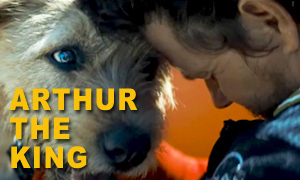Dog Gone: History vs. Hollywood
Dog Actor
Yellow Lab
Gonker
Golden Retriever Mix
Johnny Berchtold
Born: July 7, 1994
Birthplace:
Atlantic City, New Jersey, USA
Fielding 'Fields' Marshall
Born: abt 1971
Birthplace: Virginia, USA
Rob Lowe
Born: March 17, 1964
Birthplace:
Charlottesville, Virginia, USA
John Marshall
Birthplace: USA
Pictured with Fielding's sister, Peyton Marshall
Kimberly Williams-Paisley
Born: September 14, 1971
Birthplace:
Rye, New York, USA
Virginia 'Ginny' Marshall
Birthplace: USA
Is Dog Gone based on a true story that happened to the book's author?
The Netflix movie is based on the 2016 book Dog Gone: A Lost Pet's Extraordinary Journey and the Family Who Brought Him Home. While the fact-based book is not autobiographical, its author, Pauls Toutonghi, does have a direct connection to the real-life family. He married into it. Toutonghi's wife, Peyton Marshall, is the sister of Fielding Marshall, the young man who was Gonker the dog's owner. Toutonghi's father-in-law is John Marshall, who is portrayed by Rob Lowe in the film. Kimberly Williams-Paisley's character is based on his mother-in-law, Virginia 'Ginny' Marshall.
Pauls Toutonghi got the idea for the book after his wife's family told him the story. "This was the Marshalls' famous family story," Toutonghi says. "When they told it to me, I was really captivated. Ginny is a great storyteller in person, and so is John, actually. The two of them together are just kind of a force of nature." Toutonghi says that he was originally going to write the story and give it to the family as a Christmas gift. However, he changed his mind after talking with Ginny more and realizing there was enough there for a published book. -Lewis & Clark College
When did the real-life story that inspired Dog Gone take place?
A Dog Gone fact-check reveals that the real-life story of the lost dog Gonker unfolded in 1998 in McLean, Virginia and other nearby areas. By that point, the dog's real-life owner, Fielding 'Fields' Marshall, had found a job writing Javascript code and was living not far from his parents in an apartment in Vienna, Virginia. The movie sets the story in what appears to be the present day and depicts Fielding as still living with his parents when Gonker goes missing.
What kind of dog was Gonker?
One of the differences between the movie and the Dog Gone true story is that in the movie, the dog is a Yellow Lab, but in real life, the missing dog Gonker was a six-year-old Golden Retriever mix. True to his breed, he loved to play fetch and could spend hours retrieving sticks. He also had a reputation for looking out for the humans around him. On one occasion, he barked frantically to wake his owner, Fielding Marshall, after a house party. One of Fielding's friends had passed out on the bathroom floor and there was a poisonous snake slithering nearby. -NY Post
Who did the real-life Gonker belong to?
Like in the movie, the real Gonker the dog belonged to the Marshalls' son, Fielding Marshall. He adopted the dog from the local SPCA in an effort to help himself heal emotionally after the death of his infant daughter. Gonker became Fielding's best friend. The movie fictionalizes his motivation for getting the dog. He's bummed after seeing an ex-girlfriend on campus with another guy.
How did Fielding Marshall's infant daughter die?
As mentioned above, this part of Fielding Marshall's life, which is what actually motivated him to adopt Gonker, is excluded from the film. Fielding's baby girl passed away in 1991 during a procedure to repair her heart. The baby's mother, who was Fielding's girlfriend at the time, reacted to the loss by packing up her belongings and disappearing without saying goodbye, leaving Fielding to grieve alone. Drowning under an "oceanic wave of sadness," Fielding decided that a dog might help him heal. -NY Post
Could Gonker really toss a donut into the air and catch it in his mouth?
Yes. This impressive feat is described in the Dog Gone book. Gonker loved donuts and would eat them by nudging the donut along the ground until he could get the tip of his nose inside of it. He would then throw the donut into the air and catch it in his mouth as it came back down.
Was Gonker lost on the Appalachian Trail?
Yes. In researching how accurate is Dog Gone on Netflix, we learned that on October 10, 1998, six-year-old Gonker bolted into the woods while he was hiking with his owner, Fielding Marshall, on the Appalachian Trail close to the Blue Ridge Parkway near Catawba. Fielding began to desperately search for his beloved companion, but there was no sign of the dog. Would Gonker be able to survive the cold? Would a hunter mistake Gonker for a deer? Would he be found before he needed his next monthly injection that kept him alive? These were some of the questions that Fielding asked himself.
What disease did Gonker the dog have?
The missing dog Gonker suffered from Addison's Disease, which is characterized by inadequate levels of corticosteroid hormones produced by the adrenal glands next to the kidneys. These "stress" hormones, which are also produced in humans, help dogs adapt to stressful situations. When not enough are produced, the tiniest of stressors can lead to shock, coma, and death. A common cause of Addison's Disease is when the immune system attacks the adrenal glands. As in Gonker's case, treatment includes monthly injections of synthetic hormones.
How long did the family have to find Gonker to give him his lifesaving shot?
According to Pauls Toutonghi's book, the Dog Gone movie true story confirms that the Marshall Family had 23 days to find the beloved pet before he could slip into a coma and his condition would become critical. Gonker had Addison's disease and needed monthly shots of synthetic hormones to stay alive. He went missing on October 10th and was due for his next injection on November 2nd. -The Daily News Leader
Did Fielding Marshall search for Gonker with his father, John Marshall?
Yes. Fielding 'Fields' Marshall plastered the neighborhood with fliers. He and his father, John Marshall, set out along the Appalachian Trail to search for Gonker. They took the family's other dog, Uli, with them during their search (in the film, they borrow a friend's dog). Fielding's mother, Ginny, set up a command center at home. She used a map to coordinate the search and started to contact every animal shelter, community center, police station, and media outlet in the area. She also reached out to stores, churches, and park rangers. His sister, Peyton Marshall, also helped. It wasn't long before scores of people in the community were keeping an eye out for the lost dog Gonker.
The Netflix Dog Gone movie depicts Fielding and his father's search for Gonker as a much-needed opportunity for them to reconnect. This is largely how it's depicted in the book as well.
Did Fielding and his father use a megaphone in their search for Gonker?
Yes. In the movie, Fielding Marshall and his father, John, use a megaphone to call for Gonker during their search. This comes straight from the Dog Gone true story. In fact, the megaphone that the family used is still on display at the Marshall house, reminding them of when they came together as a family to find Fielding's lost dog. -NY Post
Did the Marshall Family's search for Gonker attract the attention of a local newspaper?
Yes. The search for Gonker caught the attention of the local newspaper in Waynesboro. The story ended up on the AP news wire. Tips from across the country began to roll in as various media outlets reported on the story.
An October 15, 1998 news story read, "The family is fearful that [Gonker] is hungry, confused and frightened." Another article five days later in The Daily News Leader was titled, "Vienna man searches for lost dog named 'Gonker'".
Was the mother, Virginia Marshall, abused as a child?
Yes. As a child, Virginia 'Ginny' Marshall, who is portrayed by Kimberly Williams-Paisley, was a victim of parental abuse, including by her alcoholic mother. She found solace in her beloved childhood dog, an Akita named Oji. In real life, her father, a colonel in the military, ran over Oji while backing out of the driveway. Virginia went into a depression and failed the fifth grade.
Her parents tried to have her committed and took her to a mental asylum for a psychiatric evaluation. When the doctor spoke to her alone, she told him about Oji and of how she feared her mother and had been all but abandoned by her father. Seeing that she wasn't crazy, the doctor urged her to get away from her parents and stay with a relative. She ended up going to live with her father's father, her grandfather Munson, which "saved her." As seen in the Netflix Dog Gone movie, her experience as a child and her attachment to Oji contributed to her determination to rescue Gonker.
Was Gonker found in real life?
Yes. The missing dog Gonker was found 15 days after he disappeared. A concerned citizen spotted the dog eating from trash cans behind a ski resort and reported his whereabouts to the police, who in turn phoned Fielding Marshall's mother, Ginny. She got the call at around 2 a.m. on October 25, 1998. Gonker had traveled an estimated 111 miles from Catawba to Wintergreen, Virginia, averaging approximately seven miles a day.
Fielding drove to Wintergreen to retrieve his beloved dog that had been eluding those trying to catch him. After spotting Gonker, Fielding called out to him. Gonker sprinted toward Fielding and the pair collapsed in an embraced next to his car. Both dog and owner were overwhelmed to have found each other again. Overall, Gonker was in good condition other than some cuts on his paws from the rugged terrain. He had even gained a pound during his journey. -NY Post
Did Fielding Marshall have ulcerative colitis?
Yes. However, his experience with the inflammatory bowel disease is significantly condensed in the film for dramatic effect. In real life, he suffered from the disease for several years and did nearly die. It's true that the symptoms began right after college while he was living with his parents. He had bad stomach pain, diarrhea, and often skipped meals, all of which he kept from his mother and father. He did suffer from the symptoms while searching for Gonker. The pain was so bad when he ate that he writes of making himself throw up in a hotel bathroom to get the food out of his stomach as his dad slept.
Unlike the movie, he didn't have surgery until years later. He went to the Cleveland Clinic right after Gonker passed away in 2003 and underwent surgery to remove most of his large intestine. This was roughly five years after Gonker was lost for two weeks in 1998. The movie condenses this and has him having surgery after he passes out in the driveway following his reunion with Gonker, a dramatic moment that didn't actually happen.
Where was the Netflix movie Dog Gone shot?
The Netflix movie was filmed on Stone Mountain in Georgia, not far from the southern end of the Appalachian Trail. Both the book's author, Pauls Toutonghi, and the real Fielding Marshall were extras in the film.
What happened to Gonker the dog?
While conducting our Dog Gone fact-check, we learned that after being reunited with Fielding Marshall, Gonker lived another five years. He passed away at age 11, having enjoyed a full and happy life. Fielding has since moved to Chile, attracted to the country's "untamed wilderness." He fell in love with a Chilean woman and they have two children, a boy and a girl. They also have a dog, naturally. -NY Post







